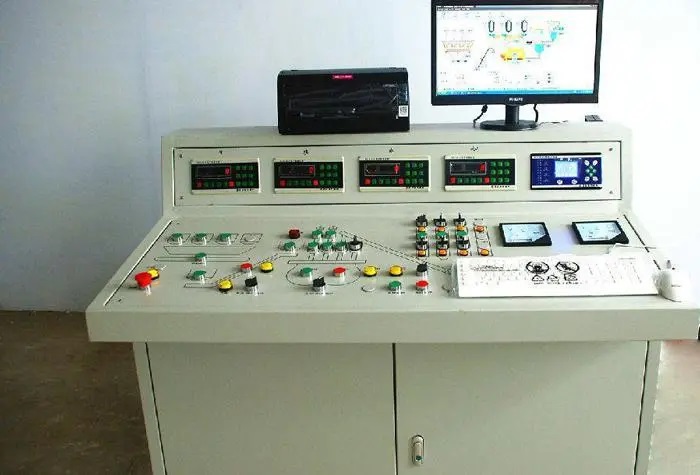Categories
- Case & News (50)
- Blog (563)
A concrete batching plant control system is the core hub that ensures efficient, accurate, safe, and stable operation. By integrating hardware and software algorithms, it enables automated control, real-time monitoring, and data traceability for the entire concrete production process (raw material storage, batching, mixing, unloading, and transportation). This directly impacts concrete production efficiency, quality stability, and operating costs. Within a concrete batching plant control system, the PLC (Programmable Logic Controller) is the core control unit, responsible for automated control of the production process, data collection and processing, fault diagnosis, and alarms.

1. The Role of the PLC in a Concrete Batching Plant Control System
– Mix Ratio Control:
The PLC monitors and controls the ratio of materials, such as water, cement, sand, and aggregate, during the concrete mixing process. By connecting to sensors, it monitors the amount of each material added in real time and controls the mixer according to preset ratios, ensuring accurate and stable concrete mix.
– Automatic Material Dosing:
The PLC automatically controls the feeding of raw materials into the concrete mixer. By connecting to equipment such as conveyors, discharge hoppers, or metering devices, the PLC automatically delivers the correct amount of materials according to preset recipes and process requirements.
– Start/Stop and Speed Control:
The PLC controls the start/stop and operating speed of the concrete mixer. By setting start and stop signals and adjusting the mixer speed, production requirements and concrete quality standards can be met.
– Mixing Time and Mode Control:
The PLC controls the mixing time and mixing mode of the concrete mixer. Mixing time can be set and different mixing modes (such as forward, reverse, or intermittent mixing) can be switched according to different material and formulation requirements to ensure concrete uniformity and quality.
– Temperature and Humidity Control:
The PLC monitors and controls temperature and humidity parameters during the concrete mixing process. By connecting temperature and humidity sensors, it monitors concrete temperature and humidity in real time and automatically adjusts cooling or heating devices to maintain appropriate operating temperature and humidity conditions.
– Alarm and Fault Detection:
The PLC provides alarm and fault detection functions for the concrete mixer. It monitors key parameters such as current, pressure, and speed, and provides real-time fault alarm information, allowing timely repair and troubleshooting measures.
2. PLC Selection
The selection of a PLC is crucial in the control system of a concrete batching plant. The PLC’s performance, reliability, scalability, and programming flexibility should be comprehensively considered based on the concrete mixing plant’s production scale, process flow, and control requirements. Common PLC brands include Siemens, Omron, and Hollysys, all of which are widely used in concrete mixing plant control systems.
3. PLC Application Examples in Concrete Mixing Plant Control Systems
– Control System Based on Siemens S7-200 PLC:
This system uses a Siemens S7-200 PLC as the slave computer and an industrial computer as the master computer. The PLC controls the entire batching and production process. Configuration software on the industrial computer transmits production tasks to the PLC, displays production animations, records and stores various data, and prints reports, enabling real-time monitoring of the production process. This system features high production efficiency and stable performance.
– Control System Based on Hollysys LK Series PLC:
This system uses a Hollysys LK series PLC as the controller, supporting redundant CPUs and high-speed analog acquisition modules. An industrial Ethernet switch enables data exchange between the operator station, touch screen, and field control station. This system features high reliability, fast computing speed, and large logical control capacity, making it particularly suitable for systems like concrete mixing plants, which require complex logic and fast data processing.
– Control System Based on Haiwei T-Series PLC:
This system utilizes a Haiwei T-series PLC and the H01WG weighing module to achieve fully automated loading, unloading, and mixing. The PLC controls two motors, an air compressor, and multiple relays, enabling equipment start/stop, forward/reverse rotation, and cement and water weighing according to the recipe set on the HMI. After unloading, the concrete is mixed and then delivered. This system features a high degree of automation, strong management and comprehensive scheduling capabilities, low cost, and high efficiency.
4. Advantages of PLC in Concrete Batch Plant Control Systems
– High Reliability:
The PLC utilizes an industrial-grade design with strong anti-interference capabilities and excellent stability, enabling long-term stable operation in harsh environments.
– Flexible Programming:
The PLC supports multiple programming languages, including ladder diagrams, instruction lists, and sequential function charts, making programming flexible and easy to learn and master.
– Strong Scalability:
The PLC’s modular design supports a variety of expansion modules, such as digital I/O modules, analog I/O modules, and communication modules, allowing for flexible configuration based on actual needs.
– Easy Maintenance:
The PLC features self-diagnostic functionality, enabling real-time monitoring of system operating status and prompt detection and alarm of faults, facilitating maintenance and troubleshooting.